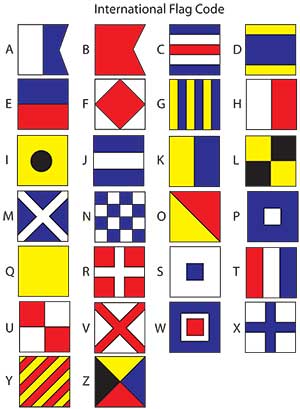International Flag Code
It is hard to imagine in these days of instantaneous global communication that for hundreds of years there was no wireless communication. When two ships met on the high seas, how did they communicate?
Flags could be used to spell out messages when crews spoke the same language. It wasn't until 1855 that the British developed the international flag code to enable communication between captains who spoke different languages. A code book with about 70,000 messages was published explaining the meaning of flag signals in nine languages: English, French, German, Greek, Italian, Japanese, Norwegian, Russian, and Spanish. With the book, captains speaking any of those languages could send and understand messages.
Some of the codes were:
- A meant a diver was underwater, keep clear.
- B meant the ship was carrying dangerous cargo.
- C meant "Yes."
- D meant "Keep clear" as the ship was having difficulty steering.
- E meant the ship was altering its course to starboard.
 F meant the ship was disabled.
F meant the ship was disabled. - G meant the ship was in need of a pilot.
- H meant a pilot was on board.
- I meant the ship was altering its course to port.
- J meant the ship was on fire and had dangerous cargo.
- K meant the ship wished to communicate.
- L meant "Stop instantly."
- M meant "I am stopped."
- N meant "No."
- O meant a man had been lost overboard.
- P meant a ship in harbor was about to sail. It signaled all personnel to return to the ship immediately. This flag was once called the blue peter.
- Q was a request to enter and use a foreign port. It signaled that the ship was healthy. No one on board had a contagious disease that would endanger others.
- S meant the ship was moving backward.
- T meant "Keep clear" because the ship was trawling.
- U meant you are moving into danger.
- V meant assistance was needed.
- W meant medical assistance was needed.
- X meant "Stop what you intend and watch my signals."
- Y meant the ship was dragging anchor.
- Z meant the ship required a tug.
- AC flown together meant the ship was being abandoned.
- AN meant a doctor was needed.
- AP meant the ship was aground.
- GN meant "You should take off persons."
- JL signaled to a ship that it was in danger of running aground.
- KP was a request for a tow to port.
- KN meant "I can't tow you."
- MY meant "It is dangerous to stop."
- NC meant "I need help."
- PM meant "Follow me."
- PP meant "Keep well clear of me."
- QQ was a request for health clearance.
- QX was a request for permission to anchor.
- QU meant "Anchoring is prohibited."
- XGE meant "I surrender." (Used in naval battle.)
- MAA meant urgent medical advice was needed.
In addition to the letter flags, there were triangular pennants for each of the numerals and an answering pennant.
Kids who are interested in codes can color the line drawings and/or cut out flags to spell their own secret messages.
Go on to Alaska 12 Days of Christmas song
Source: www.SusanCAnthony.com, ©Susan C. Anthony
